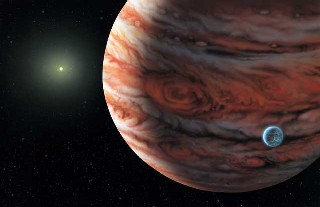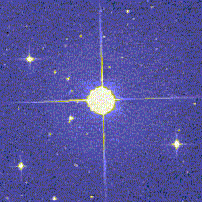Tau1 Gruis, the star that the newly discovered exoplanet orbits around.
Courtesy of NASA/JPL
More than 100 planets orbit distant stars!
News story originally written on September 25, 2002
Astronomers have found another planet outside our solar system. That makes a total of 102 exoplanets that have been found so far!
The astronomers that found the exoplanet, have been searching outside our solar system for planets like Earth. The planet they found is three times as far from its star as Earth is from the Sun and its mass is like Jupiter’s.
The solar system of the discovered planet looks a bit like ours. The planets are strung out in a line from the star with the larger planets further away from the star.
To look for exoplanets, astronomers look for far-away stars that look like they sway back and forth. They look like they sway because the planets pull on the star as they orbit around it.
After astronomers find exoplanets that are like Earth, they will look for evidence of life. Perhaps they will someday find that we are not alone in the universe!
You might also be interested in:

A team of scientists found 13 planets that are outside our solar system. Because these planets are outside our solar system, they are called exoplanets. One of these exoplanets is special because it may
...more
It was another exciting and frustrating year for the space science program. It seemed that every step forward led to one backwards. Either way, NASA led the way to a great century of discovery. Unfortunately,
...more
The Space Shuttle Discovery lifted off from Kennedy Space Center on October 29th at 2:19 p.m. EST. The sky was clear and the weather was great. This was the America's 123rd manned space mission. A huge
...more
Scientists found a satellite orbiting the asteroid, Eugenia. This is the second one ever! A special telescope allows scientists to look through Earth's atmosphere. The first satellite found was Dactyl.
...more
The United States wants Russia to put the service module in orbit! The module is part of the International Space Station. It was supposed to be in space over 2 years ago. Russia just sent supplies to the
...more
A coronal mass ejection (CME) happened on the Sun last month. The material that was thrown out from this explosion passed the ACE spacecraft. ACE measured some exciting things as the CME material passed
...more
Trees and plants are a very important part of this Earth. Trees and plants are nature's air conditioning because they help keep our Earth cool. On a summer day, walking bare-foot on the sidewalk burns,
...more















